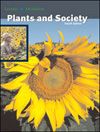 |
1 |  | 
1. The cluster of pollen-producing stamens in a flower is collectively referred to as the __________. |
|  | A) | a. ovary |
|  | B) | b. stamen |
|  | C) | c. gynoecium |
|  | D) | d. androecium |
|  | E) | e. none of the above |
 |
 |
2 |  | 
2. Which of the following is NOT a part of the carpel? |
|  | A) | a. ovule |
|  | B) | b. stigma |
|  | C) | c. ovary |
|  | D) | d. style |
|  | E) | e. anther |
 |
 |
3 |  | 
3. The most efficient way to propagate tulips is by dividing the bulb, since it takes 7 years for a seed-produced bulb to flower. |
|  | A) | True |
|  | B) | False |
 |
 |
4 |  | 
4. Tulips with boldly contrasting stripes or feathering on their petals are produced by the effects of |
|  | A) | a. freezing the bulb for a short period of time. |
|  | B) | b. the tulip breaking virus. |
|  | C) | c. aphids. |
|  | D) | d. fungal hyphae. |
|  | E) | e. a and c are correct. |
 |
 |
5 |  | 
5. Hypogynous flowers have flower parts inserted below a superior ovary. |
|  | A) | True |
|  | B) | False |
 |
 |
6 |  | 
6. The terms actinomorphic and zygomorphic refer to |
|  | A) | a. asexual reproduction. |
|  | B) | b. chromosome arrangement. |
|  | C) | c. flower symmetry. |
|  | D) | d. tulip propagation. |
|  | E) | e. presence or absence of perianth. |
 |
 |
7 |  | 
7. Flowers are described as “perfect” when: |
|  | A) | a. both sepals and petals are present. |
|  | B) | b. both stamens and carpels are present. |
|  | C) | c. only sepals, petals, stamens, and carpels are present. |
|  | D) | d. stamens, carpels are present irrespective of the presence or absence of sepals and petals. |
|  | E) | e. none of the above. |
 |
 |
8 |  | 
8. Spikes, umbels, racemes, and catkins are all types of inflorescences. |
|  | A) | True |
|  | B) | False |
 |
 |
9 |  | 
9. Eggs and sperm are types of __________. |
|  | A) | a. haploid cells. |
|  | B) | b. gametes. |
|  | C) | c. zygotes. |
|  | D) | d. homologous chromosomes. |
|  | E) | e. a and b are correct. |
 |
 |
10 |  | 
10. Chiasmata are places on the chromosome where crossing-over has occurred. |
|  | A) | True |
|  | B) | False |
 |
 |
11 |  | 
11. The generative nucleus and the tube nucleus are found in the |
|  | A) | a. pollen grain. |
|  | B) | b. ovule. |
|  | C) | c. megaspore mother cell. |
|  | D) | d. microspore mother cell. |
|  | E) | e. none of the above. |
 |
 |
12 |  | 
12. The study of pollen is called palynology. |
|  | A) | True. |
|  | B) | False |
 |
 |
13 |  | 
13. The mature female gametophyte contains |
|  | A) | a. 3 antipodal nuclei, 2 polar nuclei, 2 synergids, and 1 egg nucleus. |
|  | B) | b. a tetrad of 4 spores. |
|  | C) | c. a generative nucleus and vegetative nucleus. |
|  | D) | d. the ovule. |
|  | E) | e. two sperms and a vegetative nucleus. |
 |
 |
14 |  | 
14. Large showy flowers are usually wind-pollinated, whereas small inconspicuous flowers usually attract animal pollinators. |
|  | A) | True |
|  | B) | False |
 |
 |
15 |  | 
15. Night-flying pollinators such as moths and bats are attracted to ________ flowers. |
|  | A) | a. purple |
|  | B) | b. blue |
|  | C) | c. red |
|  | D) | d. white or light-colored |
|  | E) | e. green or yellow |
 |
 |
16 |  | 
16. The triploid endosperm is produced by the fusion of the tube nucleus and the egg cell. |
|  | A) | True |
|  | B) | False |
 |
 |
17 |  | 
17. The formation of a fruit without a real fertilization is referred to as ___________. |
|  | A) | a. Parthenocarpy |
|  | B) | b. Synapsis |
|  | C) | c. double fertilization |
|  | D) | d. only a and c |
|  | E) | e. none of the above |
 |



 2006 McGraw-Hill Higher Education
2006 McGraw-Hill Higher Education